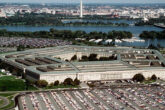August 12, 2014
Airpower’s Remarkable Accomplishment
The Pentagon’s announcement on Monday that little more than a dozen airstrikes managed to blunt ISIL’s advances, along with media reports that the bombings enabled 20,000 trapped refugees to escape, illustrates what even a very limited but precise application of airpower can do in situations like this.
That such a small group of aviators could accomplish in a matter of days what thousands of Iraqi and Kurdish boots-on-the-ground were apparently unable to do highlights not just the physical capabilities of American air power, but also its psychological impact.
Context is, of course, important. Although Secretary of Defense Hagel enthusiastically described the airstrikes as “very effective,” the Pentagon’s Lt. Gen. William Mayville was more muted as he understandably dampened expectations by saying simply that the strikes had “slowed ISIL’s operational tempo and temporarily disrupted their advances toward the province of Erbil.”
Still, what Mayville did not say - but what military experts know - is that a mere 15 airstrikes is but a tiny sliver of what a “competent, coherent, holistic air campaign” could do. Consider that the first day of Operation Iraqi Freedom saw more than 1,700 air and missile sorties launched against Iraq. By April 2003, that number grew to over 41,000, with more than 18,000 of them being fighter or bomber missions. In other words, ISIL has gotten only a taste of what life under air attack could be like.
What is particularly interesting is General Mayville’s expectation that the airstrikes will cause ISIL “to look for other things to do… to pick up and move elsewhere.” What he is actually describing is the psychological effect of modern airpower against organized land forces devoid of air defenses. Up to this point ISIL really hasn’t needed to implement the dispersion, camouflage, and stealth tactics that other insurgencies employ to avoid destruction from a US air attack. That omission could be costly for them.
ISIL likes to gather its fighters together into convoys and openly and brazenly advance, black flags flying, against opponents who are often terrified of their brutal tactics, and who are seldom better armed than ISIL. That kind of intimidation might work with some adversaries, but operating “openly and brazenly” is a death warrant when facing American airpower.
ISIL fighters may not be afraid to die, but being blasted into nothingness by airstrikes is likely not the glorious death they envision for themselves. Moreover, the stress of not knowing if or when they might be struck can inflict a psychological strain that can sap strength from any fighting force. It is the ability to inflict a sense of helplessness that makes American airpower such a fearsome weapon.
To be sure, no one should ever think that airpower alone is the solution to the complicated problems of Iraq. Nevertheless, it is remarkable what a couple of warplanes achieved in just a few days. And there are 20,000 reasons to be grateful.
More from CNAS
-
The Department of Defense’s Breakthrough Nuclear Moment Risks Slipping Away
Unless they act, the Department of Defense’s breakthrough nuclear moment may vanish before it really happens....
By Will Rogers
-
Sharper: The Budget
The defense budget and its $715 million price tag accounts for much of the U.S. government's discretionary spending every year, but where will (and should) this money go in th...
By Anna Pederson
-
Three elements of Army’s iron triangle equally critical for United States, says defense analyst
Billy Fabian, adjunct senior fellow for the Defense Program at the Center for a New American Security and senior analyst at Govini discusses the Army's iron triangle on Govern...
By Billy Fabian
-
The Fiscal Year 2022 Defense Budget and Future Options for the Pentagon
Submitted Written Testimony I. Introduction Chairman Smith, Ranking Member Rodgers, distinguished members of the committee and staff thank you for inviting me to testify today...
By Stacie Pettyjohn



